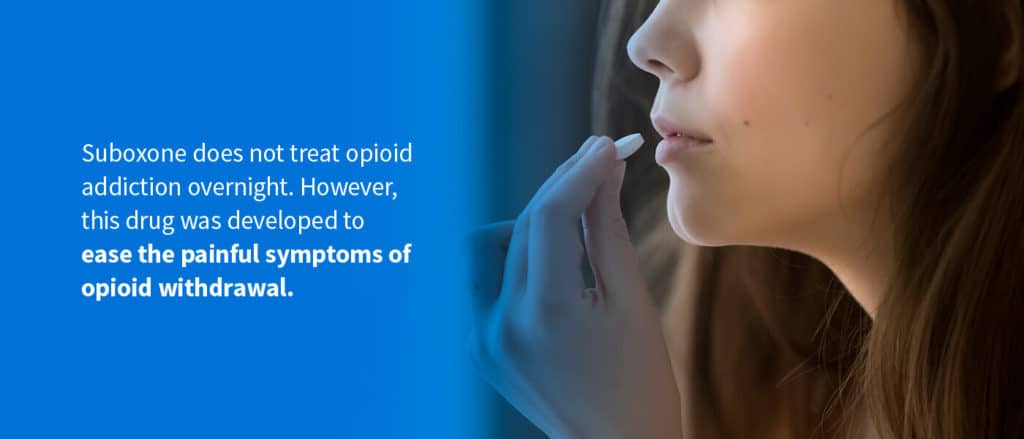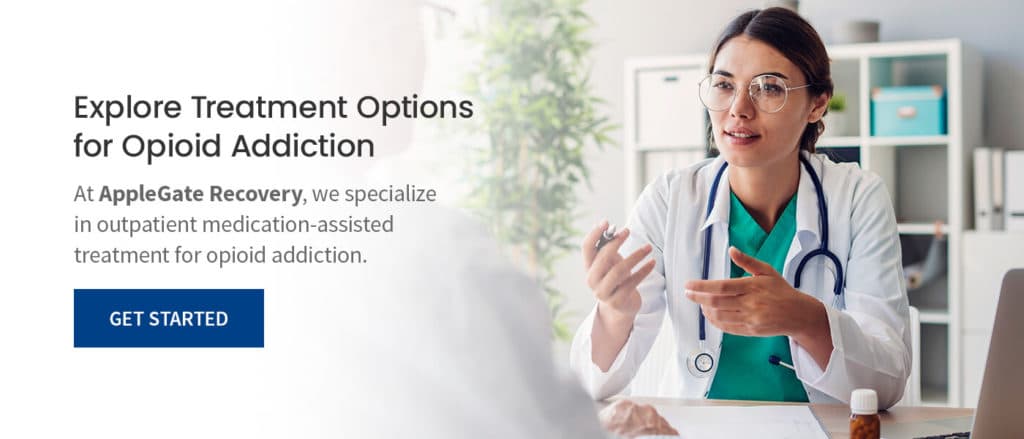One of the most common drugs used in treating opioid addiction is called Suboxone. Suboxone is the brand name for a combination of two drugs — buprenorphine and naloxone. This drug is often used as part of medically assisted treatment programs, also known as MAT. Generic versions of this drug are also available. A doctor that has the X-DEA license or X-Waiver is the only one who can prescribe this medication.
In simple terms, Suboxone helps with eliminating withdrawal symptoms and cravings. It’s a significant aspect of opioid addiction treatment for many people because it allows them to focus on their recovery and avoid further opioid abuse.

How Suboxone Works
Suboxone helps in the treatment of opioid addiction in a few key ways. To understand it, you have to know more about its components.
Buprenorphine, which is the main element of Suboxone, helps cover the opioid receptors in the brain. It eliminates or helps reduce the withdrawal pain. Buprenorphine acts like an opioid in low to moderate doses. The drug naloxone, which is the other component of this medicine, functions as an opioid blocker. Its major goal is to counteract the euphoric high feeling that comes from opioid use. Together, these two drugs reduce the risk of overdosing and drug dependency.
For a more thorough overview of how this medicine works, keep in mind that the brain develops an increased tolerance for opioids with extended use. Think of an opioid receptor in the brain of someone who has been using opioids for some time. When that receptor is empty, the person will feel discomfort. When the receptor is filled with a full-agonist or the opioid, they will feel a euphoric high. This cycle is the reason opioids are so addictive.
Buprenorphine takes the opioid’s place in the brain’s receptors and blocks the full-agonist opioid from reaching them. The resulting euphoric high is limited. This effect continues even as the buprenorphine wears off or dissipates. Therefore, the individual’s cravings and withdrawal effects are also limited.
Suboxone does not treat opioid addiction overnight. However, this drug was developed to ease the painful symptoms of opioid withdrawal. It can be an excellent option for someone who is ready to stop using opioids but needs help managing the symptoms of their brain’s dependence on the drug.
How Suboxone Plays a Role in Treatment
At AppleGate Recovery, our process does not end with the prescription of Suboxone. There are three phases to our treatment process. The first step is called the induction phase, where the patient is introduced to the medicine prescribed by a certified doctor. Only approved products are used for the treatment.
After induction, the second phase of the treatment plan, called the stabilization phase, can begin. This phase starts when a recovering patient does not face severe withdrawal symptoms and no longer has opioid cravings. This stage might include lowering the dosage of Suboxone.
Once the second phase is done, the third phase of maintenance begins. Maintenance can start when the patient is doing well on a specific dose of the medication. The time frame for the steady use of medication depends on the person.
Throughout these phases, treatment may also include counseling and other recovery services. Suboxone is just one part of a larger strategy to aid in recovery.
Why Do Addicts Need Suboxone?
Recovering from opioid addiction is a challenging task. The brain and body can come to depend on opioids after continued use, even if the opioid was originally prescribed by a doctor. The Suboxone treatment program allows opioid addicts to minimize their withdrawals and cravings and get back to their normal lives.
Some of the symptoms of opioid withdrawal include:
- Anxiety
- Racing heart
- Insomnia
- High blood pressure
- Diarrhea
- Nausea and vomiting
- An increase in body temperature
- Bone and muscle pain
- Chills
- Sweating
These symptoms go away when the individual uses opioids again, continuing the cycle of addiction. Suboxone is a healthier way to manage these symptoms and cravings. For some people, a drug like this is the only option to avoid going into a relapse.
The Benefits of Suboxone
The greatest benefit of any treatment option is recovery and a life free from addiction to drugs. Here are some of the major advantages of Suboxone specifically:
- A fast start: One ofSuboxone’s most significant benefits is that patients can start using it within 12 to 24 hours of drug abuse. After they have met with a doctor and are prescribed medication, they can begin their path to recovery. The recovery path is not short, but the sooner a person can get started, the better.
- Reduced withdrawal symptoms: With this medication, opioid addicts can avoid or lower their withdrawal pain. If they were to stop their opioid use on their own, they would have painful withdrawal symptoms and a strong craving for the drug. They will be more likely to give up their recovery and begin to abuse opioids again. With Suboxone, the withdrawal pain becomes more tolerable and can be managed with less difficulty.
- Lasting effects: Unlike many other medications, Suboxone is long-acting. This medication does not need to be taken every few hours to work. It blocks opioid receptors even as it starts to dissipate.
Explore Treatment Options for Opioid Addiction
At AppleGate Recovery, we specialize in outpatient medication-assisted treatment for opioid addiction. Our treatment is individualized for every patient we see. Our approach includes medication for treating opioid addiction as well as counseling and other recovery services.
If you have any questions about our services, the medication we use or anything else, please reach out to us. We are committed to helping you or your loved one live a life free from addiction. Contact us today to learn more about our treatment process and how Suboxone works. Addiction isn’t a choice, but recovery can be.

Contact AppleGate Recovery Today
If opioid addiction is impacting your life or the life of someone you care about, reach out to our treatment center. We are here to provide the support and care you need to take the first step toward recovery.
Call 888.488.5337

